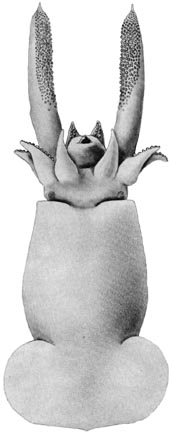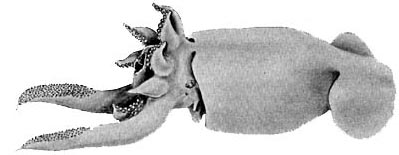Promachoteuthis sp. B
Richard E. Young and Michael VecchioneIntroduction
Promachoteuthis sp. B is known mostly from three, very small specimens (10.5, 16.4 and 17 mm ML) and from one larger (50 mm ML) squid, recently described by Salcedo-Vargas and Guerrero-Kommrits (2000) as Promachoteuthis sp., that probably belongs to this species. If this latter identification is correct, then this species is the only member of the genus with a distribution in both the Atlantic and Pacific Oceans.
Diagnosis
A promachoteuthid...- with nuchal fusion between head and mantle.
- with arm suckers about equal in size to club suckers.
- with tentacle base wider than arm III base.
- with extremely small eyes.
Characteristics
- Arms
- Arms short (20-25% of ML).
- Arms short (20-25% of ML).
- Tentacles
- Short, thick (length < ML); base wider than arms III.
- Proximal club boundary with tentacle stalk marked by distinct reduction in tentacle diameter.
- Club bears about 20 series of suckers.
- Large club suckers approximately the same size as large arm suckers (judging from drawings).
- No dark pigment band near base; stalk lightly pigmented.
Figure. Oral view of tentacle of Promachoteuthis sp. B, 17 mm ML. Drawing from Roper and Young (1968).
- Head and funnel
- Head fused to mantle in nuchal region.
- Eyes very small (0.8 mm in 17 mm ML squid).
Figure. Side view of Promachoteuthis sp. B showing nuchal fusion, 17 mm ML. Drawing from Roper and Young (1968).
Comments
The above discription is taken from Roper and Young (1968). More details of the description can be found here.
Life History
The smallest known specimen (see drawing) is 10.5 mm ML and looks much like the larger specimen except that the fins are relatively smaller.
Figure. Ventral view of Promachoteuthis. sp. B, 10.5 mm ML. Drawing from Roper and Young (1968).
Distribution
Promachoteuthis sp. B was originally described from two locations in the eastern South Pacific at 33°18'S, 72°27'W (0-1800 m) and 56°06'S, 79°04'W (ca. 0-1400 m). Toll (1982) described the gladius of another specimen from the same general area at 34°11'S, 80°46°W (0-2972 m) which was subsequently illustrated in Voss (1992). Voss (1992) reported a forth, undescribed, specimen from about 57°S, 170°E, in the western South Pacific, south of New Zealand. A fifth squid, that we tentatively identify to this species, was described by Salcedo-Vargas and Guerrero-Kommritz (2000) from the western North Atlantic at 42°44'N, 13°29.W (depth not given). If these are all correct identifications, this species has the broadest distribution of any species in the genus.
References
Okutani, T. 1983. Rare and interesting squid from Japan. VIII. Rediscovery of Promachoteuthis megaptera Hoyle, 1885 (Oegopsida: Promachoteuthidae). Venus 42: 241-247.
Roper, C. F. E. and R. E. Young. 1968. The family Promachoteuthidae (Cephalopoda: Oegopsida). I. A re-evaluation of its systematic position based on new material from Antarctic and adjacent waters. Ant. Res. Ser. 11: 203-214.
Salcedo-Vargas, M. A. and J. Guerrero-Kommritz. 2000. Three new cephalopods from the Atlantic Ocean. Mitt. Hamb. Zool. Mus. Inst., 97: 31-44.
Voss N. A. 1992. Family Promachoteuthidae. Smithson. Contr. Zool., 513: 183-185.
Title Illustrations

About This Page

University of Hawaii, Honolulu, HI, USA

National Museum of Natural History, Washington, D. C. , USA
Page copyright © 2016 and
 Page: Tree of Life
Promachoteuthis sp. B.
Authored by
Richard E. Young and Michael Vecchione.
The TEXT of this page is licensed under the
Creative Commons Attribution-NonCommercial License - Version 3.0. Note that images and other media
featured on this page are each governed by their own license, and they may or may not be available
for reuse. Click on an image or a media link to access the media data window, which provides the
relevant licensing information. For the general terms and conditions of ToL material reuse and
redistribution, please see the Tree of Life Copyright
Policies.
Page: Tree of Life
Promachoteuthis sp. B.
Authored by
Richard E. Young and Michael Vecchione.
The TEXT of this page is licensed under the
Creative Commons Attribution-NonCommercial License - Version 3.0. Note that images and other media
featured on this page are each governed by their own license, and they may or may not be available
for reuse. Click on an image or a media link to access the media data window, which provides the
relevant licensing information. For the general terms and conditions of ToL material reuse and
redistribution, please see the Tree of Life Copyright
Policies.
Citing this page:
Young, Richard E. and Michael Vecchione. 2003. Promachoteuthis sp. B. Version 01 January 2003. http://tolweb.org/Promachoteuthis_sp._B/19530/2003.01.01 in The Tree of Life Web Project, http://tolweb.org/














 Go to quick links
Go to quick search
Go to navigation for this section of the ToL site
Go to detailed links for the ToL site
Go to quick links
Go to quick search
Go to navigation for this section of the ToL site
Go to detailed links for the ToL site